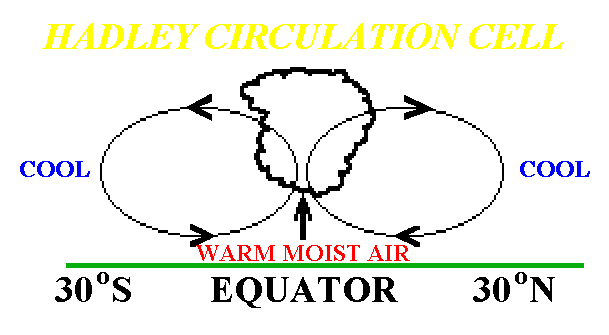

Thermal and three-cell circulation
You know equatorial areas receive more direct solar radiation than do polar areas. Also, in the lower latitudes, the ratio of land to water is low. Since water loses heat slowly, more heat is received than lost through radiation. In the polar regions, just the opposite is true. The land to water ratio is high and more heat is lost due to radiation than is received. Since the Tropics do not become progressively hotter and polar regions colder, there must be a transfer of heat between the two regions or a general circulation. The mechanism that sets up Earth’s general circulation pattern is the latitudinal transfer of heat.
Thermal circulation
If the Earth’s surface were smooth, uniform, and stationary, atmospheric circulation would be very simple. The atmosphere would act as a contained fluid and movements within this fluid would be the convective currents caused by temperature and density differences. The latitudinal transfer of heat would result in a single circulation cell.
Figure 2–11. Thermal circulation (single cell).
Unequal heating is the main driving mechanism responsible for the Earth’s atmospheric circulations. The Equator receives more heat than the poles. The warm equatorial air rises and expands until it reaches the tropopause. The tropopause stops the upward motion of this air, causing it to spread and move toward the colder polar regions. Simultaneously, cold and dense air at the poles sinks and starts to flow toward the Equator, replacing the warm air rising in this region. This creates the single cell circulation model possible only on a non-rotating Earth (fig. 2–11).
Three-cell circulation
This theory of circulation best describes the Earth’s general circulation because it considers effects of coriolis force due to the Earth’s rotation. In this circulation model, the Northern and Southern Hemisphere are each divided into three cells of circulation, each spanning 30 degrees of latitude. The latitudes that mark the boundaries of these cells are the Equator, 30° North and South, and 60° North and South. For our purposes, we consider only the Northern Hemispheric cells shown in figure 2–12:
Hadley.
| Polar.
| Ferrel. | |

Figure 2–12. Three-cell circulation.
Hadley cell
George Hadley, an English meteorologist, theorized this first circulation cell in 1735. The Hadley cell is the strongest of the three cells of circulation and is formed as warm air rises above the Equator and starts to flow northward. The northward flow deflects to the right, due to coriolis, becoming an upper-level westerly flow. As this air moves northeastward toward the pole, it cools and a portion of it sinks at about 30°N. This sinking air spreads northward and southward as it nears the surface. The southward moving air again deflects to the right, becoming the northeasterly trade winds.
Because of the circulation in the Hadley cell, two pressure belts are created. The first is a belt of semipermanent high pressure that results from the sinking air at 30°. This belt of high pressure is called the subtropical ridge. The second pressure belt is a trough of low pressure near the Equator. It is called the near equatorial trough.
Polar cell
This is the northernmost cell of circulation and its mean position is between 60°N and the North Pole. At the pole, cold, dense air descends, causing an area of subsidence and high pressure. As the air sinks, it begins spreading southward. Since the coriolis force is strongest at the poles, the southward moving air deflects sharply to the right. This wind regime is called the surface polar easterlies, although the upper winds are still predominantly from the southwest. Near 60ºN, the southeasterly moving air moving along the surface collides with the weak, northwesterly surface flow that resulted from spreading air at 30°N. This colliding air rises, creating a belt of low pressure near 60°N.
Ferrel cell
The mid-latitude circulation cell between the Polar cell and the Hadley cell is called the Ferrel cell. This cell is named after William Ferrel, a Nashville school teacher who first proposed its existence. Oddly enough, Mr. Ferrel published his observations in a medical journal in 1856.
The Ferrel cell circulation is not as easily explained as the Hadley and Polar cells. Unlike the other two cells, where the upper and low-level flows are reversed, a generally westerly flow dominates the Ferrel cell at the surface and aloft. It is believed the cell is a forced phenomena, induced by interaction between the other two cells. The stronger downward vertical motion and surface convergence at 30°N coupled with surface convergence and net upward vertical motion at 60°N induces the circulation of the Ferrel cell. This net circulation pattern is greatly upset by the exchange of polar air moving southward and tropical air moving northward. This best explains why the mid-latitudes experience the widest range of weather types.
 |
|
|
|---|
|
Persistent net radiational heating of the tropical earth surface leads to widespread occurrence of static instability of the tropical atmosphere. Large amounts of evaporation from the sun-warmed oceans also assures ample supplies of water vapor in the air. There is, consequently, a large scale, persistent band of organized convection throughout the tropics called the Inter Tropical Convergence Zone (ITCZ). The ITCZ extends along a long band in the deep tropics, and can often be traced aound the whole globe. This persistent band of organized convection draws air into it al low levels from latitudes north and south of its location.
|
Another view (a side view) of the three main general circulation patterns are shown below. The tropics are mainly dominated by the Hadley circulation (carrying mid-latitude toward the Inter-Tropcial Convergence Zone (ITCZ)
![]()
![]()